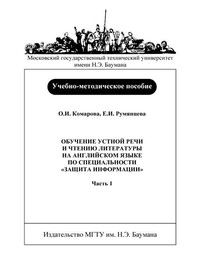Обучение устной речи и чтению литературы на английском языке по специальности «Защита информации». Часть 1
Покупка
Тематика:
Английский язык
Год издания: 2010
Кол-во страниц: 32
Дополнительно
Вид издания:
Учебно-методическая литература
Уровень образования:
ВО - Бакалавриат
Артикул: 840499.01.99
Пособие состоит из трех тематических разделов: первый включает тексты об основных принципах информационной защиты, второй - о компьютерных вирусах, третий - о способах защиты (ключах и криптографии). Предлагаются тексты для ознакомительного чтения и краткого изложения содержания прочитанного. Тексты представляют собой статьи или извлечения из статей англоязычных авторов. Представлены также упражнения на понимание текста, отработку и закрепление лексико-грамматических конструкций, развитие навыков устной речи. Для студентов 3-го курса, обучающихся по специальности «Защита информации».
Тематика:
ББК:
УДК:
ОКСО:
- ВО - Бакалавриат
- 00.03.02: Иностранный язык
- 10.03.01: Информационная безопасность
ГРНТИ:
Скопировать запись
Фрагмент текстового слоя документа размещен для индексирующих роботов
Московский государственный технический университет имени Н.Э. Баумана О.И. Комарова, Е.И. Румянцева ОБУЧЕНИЕ УСТНОЙ РЕЧИ И ЧТЕНИЮ ЛИТЕРАТУРЫ НА АНГЛИЙСКОМ ЯЗЫКЕ ПО СПЕЦИАЛЬНОСТИ «ЗАЩИТА ИНФОРМАЦИИ» В трех частях Часть 1 Учебно-методическое пособие Москва Издательство МГТУ им. Н.Э. Баумана 2010
УДК 802.0
ББК 81.2 Англ-923
К63
Рецензент И.Ф. Беликова
Комарова О.И.
Обучение устной речи и чтению литературы на английском языке по специальности «Защита информации» : учеб.метод. пособие: в 3 ч. – Ч. 1 / О.И. Комарова, Е.И. Румян-
цева. – М. : Изд-во МГТУ им. Н. Э. Баумана, 2010. – 30, [2] с.
Пособие состоит из трех тематических разделов: первый вклю
чает тексты об основных принципах информационной защиты, второй – о компьютерных вирусах, третий – о способах защиты (ключах и криптографии). Предлагаются тексты для ознакомительного
чтения и краткого изложения содержания прочитанного. Тексты
представляют собой статьи или извлечения из статей англоязычных
авторов. Представлены также упражнения на понимание текста, отработку и закрепление лексико-грамматических конструкций, развитие навыков устной речи. Для студентов 3-го курса, обучающихся
по специальности «Защита информации».
УДК 802.0
ББК 81.2 Англ-923
Учебное издание
Комарова Ольга Ивановна
Румянцева Елена Ивановна
Обучение устной речи и чтению литературы на английском языке
по специальности «Защита информации»
Часть 1
Корректор Р.В. Царева
Компьютерная верстка О.В. Беляевой
Подписано в печать 18.11.2010. Формат 60×84/16.
Усл. печ. л. 1,86. Тираж 200 экз. Изд. № 31.
Заказ
Издательство МГТУ им. Н.Э. Баумана.
Типография МГТУ им. Н.Э. Баумана.
105005, Москва, 2-я Бауманская ул., 5.
© МГТУ им. Н.Э. Баумана, 2010
К63
ПРЕДИСЛОВИЕ Настоящее пособие предназначено для студентов 3-го курса (пятый семестр), обучающихся по специальности «Защита информации» (кафедра ИУ-10). Авторы пособия имеют целью формирование у студентов профессионально-ориентированной коммуникативной компетенции. В пособии представлены оригинальные тексты, степень трудности которых соответствует уровню подготовки студентов 3-го курса (пятый семестр). Состоит пособие из трех разделов (units). Их тематика соответствует тематике изучаемой специальности. В каждый раздел включены текст для чтения и перевода, послетекстовые упражнения на закрепление, отработку и использование в речи лексико-грамматических конструкций. Помимо этого в каждом разделе даны дополнительные тексты для устного изложения и обсуждения. В конце каждого раздела даны упражнения на повторение грамматического материала, лексическое наполнение которого не основано на специальной тематике. Содержание пособия позволяет студентам охватить широкий спектр информации по изучаемой специальности, активизировать пройденный ранее материал, сформировать компетенцию специализированной коммуникации.
UNIT 1
Read and translate the text.
Text A
Basic Principles of Information Protection.
Considerations Surrounding the Study of Protection
Many examples of systems requiring protection of information are
encountered every day: airline seat reservation systems, credit bureau
data banks; law enforcement information systems; time-sharing service
bureaus; on-line medical information systems; and government social
service data processing systems. These examples span a wide range of
needs for organizational and personal privacy. All have in common
controlled sharing of information among multiple users. All, therefore,
require some plan to ensure that the computer system helps implement
the correct authority structure. Of course, in some applications no special provisions in the computer system are necessary. It may be, for instance, that an externally administered code of ethics or a lack of
knowledge about computers adequately protects the stored information.
Although there are situations in which the computer need provide no
aids to ensure protection of information, often it is appropriate to have
the computer enforce a desired authority structure.
The words ‘privacy’, ‘security’, and ‘protection’ are frequently
used in connection with information-storing systems. Not all authors
use these terms in the same way. Here are the definitions commonly
encountered in computer science literature. The term ‘privacy’ denotes
a socially defined ability of an individual (or organization) to determine
whether, when, and to whom personal (or organizational) information is
to be released.
The term ‘security’ describes techniques that control who may use
or modify the computer or the information contained in it.
Security specialists have found it useful to place potential security
violations in three categories.


